Beaucarnea Guatemalensis
Beucarnea guatemalensis is native to Guatemala. The tree grows twenty feet tall. The leaves are green,…

Nyssa Sylvatica
The common names of nyssa sylvatica are tupelo, pepperidge, black gum, and sour gum. The tree grows…

Joint Detection
Two men testing for bad joints in the railway. One man holds metal poles a and b three feet apart. Wires…

Texas Longhorn
A Texas Longhorn. They are characterized by their horns, which can grow up to 7 feet for a cow, or 36…
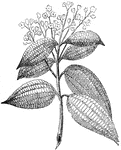
Cinnamon
The cinnamon plant. It is the inner bark of a tree growing about twenty feet high, and being peeled…

Pound Net
This net employs a 'Leader', 'Heart', 'Fore Bay', and 'Pound'. Each of these apparatus are constructed…

New Zealand Flax (Flowers)
New Zealand Flax is a liliaceous plant bearing tough, radical leaves, usually about four feet in length.…

New Zealand Flax (Fruit)
New Zealand Flax is a liliaceous plant bearing tough, radical leaves, usually about four feet in length.…
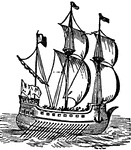
Galley (ship)
A Galley is a low, flat-built vessel furnished with one deck.It was primarily employed by the Romans,…
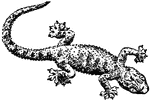
Gecko
A gecko is a small, four-footed member of the lizard family Geckonidae. Geckos are widely distributed…
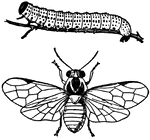
Gooseberry Caterpillar (Nematus ribesii) and Sawfly
Gooseberry Caterpillar is the name applied to the larvæ of two different insects, both injurious to…
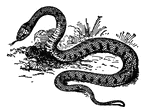
Grass Snake
Its color is olive-gray or brown above, with black bands and spots, and checkered black and white beneath.…
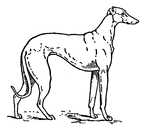
Greyhound
The Greyhound as a show dog is judged as follows: height and weight, ranging from 23 to 27 in. and from…

Carding Process in the Manufacuring of Jute
After the softening process in the manufacturing of jute, the fibers are about six feet long, and are…

Jute
Jute, also known as Calcutta Hemp, is a fiber obtained from several species of the genus Corchorus of…
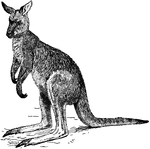
Great Kangaroo
The Great Kangaroo, or 'boomer', or 'old man' (Macropus giganteus), attains a height of about five feet…
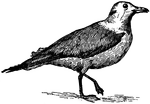
Kittiwake Gull
The Kittiwake gull (Rissa tridactyla) is a sea-gull characterized by the absence of the hind toe. It…

Klipspringer
The Klipspringer, or Kainsi, is a small but very active antelope (Oreotragus saltator), found in the…

Sea Lamprey
A lamprey is an animal which, though often regarded as a fish, differs from a fish in the absence of…

Lemniscate
A Lemniscate is, in general, a curve generated by a point moving so that the product of its distances…

Leopard
The leopard (Felis pardus) is a carnivore closely allied to the lion and the tiger, but differing it…
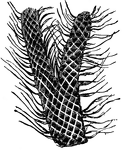
Portion of Lepidodendron
This illustration shows a portion of Lepidodendron. Lepidodendron is the generic name of a large and…

Medal of Damascus
A medal of Damascus, showing the turreted goddess holding out her right hand, a cornucopia in her left,…

Medal of Sardis
One side of the medal is engraved with the portrait of Proserpine, who was worshiped in Sardis. The…
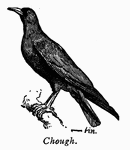
Chough
Chough, a European crow with a glossy black color, with bill, legs and feet a bright cherry red.

A Middle-Aged Man Sitting with Three Young Children
A man sits outdoors with one child on his knee, one at his side, and one at his feet. The children are…
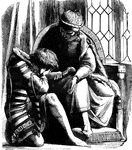
King Comforting a Young Man
A king or nobleman sits on a modest throne with a footstool and comforts a weeping young man kneeling…
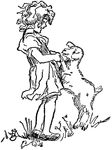
Girl with Lamb
A girl holds the forelegs of a lamb as one might hold the legs of a pet dog up so it is standing on…
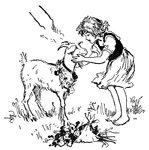
Girl and Goat
A young girl with a pet goat. The goat is wearing a garland of flowers around its neck. Another bundle…

Gooseneck Sorghum
Gooseneck sorghum, a species of grass. The Gooseneck is the largest of the sorghum varieties. IT grows…

Jesus Heals a Leper
"And when he was come down from the mountain, great multitudes followed him. And behold, there came…

Jesus Preaching, Consider the Lilies of the Field
"And why are ye anxious concerning raiment? Consider the lilies of the field, how they grow; they toil…
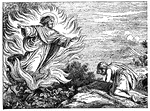
Moses and the Burning Bush
"Now Moses was keeping the flock of Jethro his father-in-law, the priest of Midian: and he led the flock…
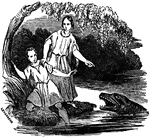
Tobias Attacked by a Monstrous Fish
"And Tobias went forward, and the dog followed him, and he lodged the first night by the river of Tigris.…

Eleazar Attacks the Elephant
"And Eleazar the son of Saura saw one of the beasts harnessed with the king's harness: and it was higher…

Puma
The puma, also known as the cougar, panther, or mountain lion (Felis concolor) , is a large American…

The Visitation - Mary Arrives at Elizabeth's Home
"And Mary arose in these days and went into the hill country with haste, into a city of Judah; and entered…
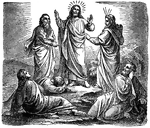
The Transfiguration of Jesus on a Mountain with Peter, James, and John
"And it came to pass about eight days after these sayings, that he took with him Peter and John and…
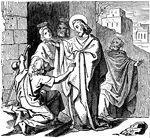
Jesus Heals a Blind Beggar named Bartimaeus at Jericho
"And Jesus answered him, and said, What wilt thou that I should do unto thee? And the blind man said…
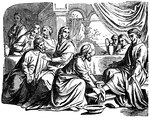
Jesus Washes the Feet of His Twelve Disciples after the Last Supper
"Then he poureth water into the basin, and began to wash the disciples' feet, and to wipe them with…
Pompeiian Stand with Lighted Oil Lamp
A tall, thin lamp stand on a round, ornamented base with three claw feet. The top of the stand has a…

Adam and Eve are Punished and Cast Out of the Garden of Eden
"So he drove out the man; and he placed at the east of the garden of Eden the Cherubim, and the flame…

Isaac Deceives Jacob and Receives Esau's Blessing
"And he discerned him not, because his hands were hairy, as his brother Esau's hands. So he blessed…

Ruth Meets Boaz While Gleaning in the Fields
"And she went, and came and gleaned in the field after the reapers: and her hap was to light on the…

Saul Tries to Kill David with His Javelin
"And an evil spirit from Jehovah was upon Saul, as he sat in his house with his spear in his hand; and…

Mary Magdalene Washes Jesus' Feet with Her Tears, Wipes Them with Her Hair, and Anoints Them with Perfume
And behold, a woman who was in the city, a sinner; and when she knew that he was sitting at meat in…

Jesus Tells Martha to Stop Worrying and Be More like Mary
"And she had a sister called Mary, who also sat at the Lord's feet, and heard his word. But Martha was…
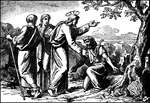
Jesus Heals Ten Lepers and Only the Samaritan Returns to Give Thanks
"And when he saw them, he said unto them, Go and show yourselves unto the priests. And it came to pass,…

Zacchaeus, the Chief Tax Collector, Climbs a Tree to See Jesus
"And behold, a man called by name Zacchaeus; and he was a chief publican, and he was rich. And he sought…
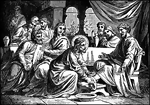
Jesus Washes the Disciples' Feet to Show the Importance of Baptism and Penance
"So when he had washed their feet, and taken his garments, and sat down again, he said unto them, Know…
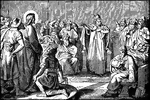
Jesus Appears Before Caiaphas, the High Priest
"Then the high priest rent his garments, saying, He hath spoken blasphemy: what further need have we…
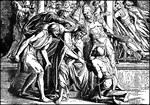
Jesus Scourged, Mocked, and Crowned with Thorns
"And they stripped him, and put on him a scarlet robe. And they platted a crown of thorns and put it…

The Crucifixion of Jesus with Two Robbers
"And with him they crucify two robbers; one on his right hand, and one on his left." Mark 15:27 ASV…

Jesus Appears to Mary Magdalene After His Resurrection
"Now when he was risen early on the first day of the week, he appeared first to Mary Magdalene, from…

Jesus Appears to Eleven of the Disciples
"And afterward he was manifested unto the eleven themselves as they sat at meat; and he upbraided them…
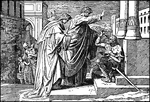
Peter Heals a Lame Beggar at the Temple
"But Peter said, Silver and gold have I none; but what I have, that give I thee. In the name of Jesus…
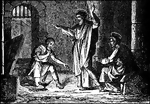
Paul and Silas in Jail - the Jailer Kneels Before Paul
"And the jailor, being roused out of sleep and seeing the prison doors open, drew his sword and was…

Paul Leaves Ephesus and Says Goodbye to the Ephesian Elders
"And after the uproar ceased, Paul having sent for the disciples and exhorted them, took leave of them,…

Peter Crucified on an Upside Down Cross
Illustration of Peter being bound to an upside down cross. One man holds his upper body, while another…
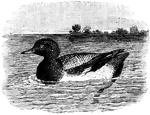
Scaup, a Common Duck
"A duck, Fuligula or Fulix marila and related species. The common scaup inhabits Europe, Asia, and North…